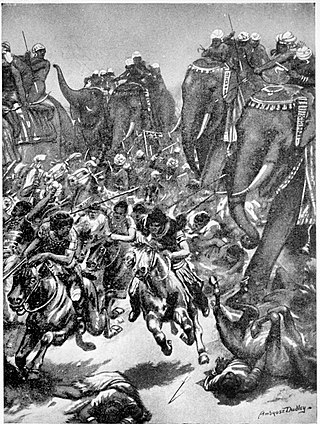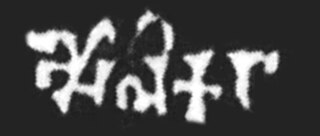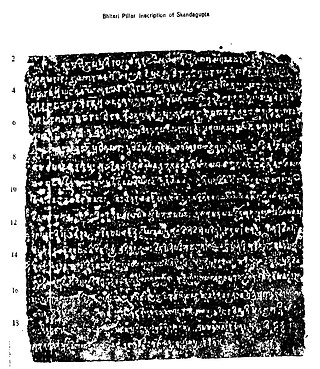The Gupta Empire was an ancient Indian empire which existed from the early 4th century CE to early 6th century CE. At its zenith, from approximately 319 to 467 CE, it covered much of the Indian subcontinent. This period has been considered as the Golden Age of India by some historians, although this characterisation has been disputed by other historians. The ruling dynasty of the empire was founded by Gupta, and the most notable rulers of the dynasty were Chandragupta I, Samudragupta, Chandragupta II and Skandagupta. The 5th-century CE Sanskrit poet Kalidasa credits the Guptas with having conquered about twenty-one kingdoms, both in and outside India, including the kingdoms of Parasikas, the Hunas, the Kambojas, tribes located in the west and east Oxus valleys, the Kinnaras, Kiratas, and others.

Kumaragupta I was an emperor of the Gupta Empire of Ancient India. A son of the Gupta emperor Chandragupta II and Queen Dhruvadevi, he seems to have maintained control of his inherited territory, which extended from Gujarat in the west to Bengal region in the east.

Skandagupta was a Gupta Emperor of India. His Bhitari pillar inscription suggests that he restored the Gupta power by defeating his enemies, who may have been rebels or foreign invaders. He repulsed an invasion by the Indo-Hephthalites, probably the Kidarites. He seems to have maintained control of his inherited territory, and is generally considered the last of the great Gupta Emperors. The Gupta genealogy after him is unclear, but he was most probably succeeded by Purugupta, who appears to have been his younger half-brother.

Yashodharman was a ruler of Malwa, in Central India, during the early part of the 6th century. He probably belonged to the Second Aulikara dynasty. He conquered much of the Indian subcontinent between c. 530-540 AD according to Mandsaur pillar inscription.

Vishnugupta Candraditya was one of the lesser-known kings of the Gupta Dynasty. He is generally considered to be the last recognized king of the Gupta Empire. His reign lasted 10 years, from 540 to 550 CE. From the fragment of his clay sealing discovered at Nalanda during the excavations of 1927–28, it is revealed that he was the son of Kumaragupta III and the grandson of Narasimhagupta.

The Harsola copper plates are a set of two 949 CE Indian inscriptions that record the grants of two villages to a Nagar Brahmin father-son duo. The grants were issued by the Paramara king Siyaka II. The copper plates were discovered in Harsol in present-day Gujarat state.

Ghatotkacha was a pre-imperial Gupta king of northern India. He was a son of the dynasty's founder Gupta, and the father of the dynasty's first emperor Chandragupta I.
The Malavas or Malwas were an ancient Indian tribe. Modern scholars identify them with the Mallian people (Malloi) who were settled in the Punjab region at the time of Alexander's invasion in the 4th century BCE. Later, the Malavas migrated southwards to present-day Rajasthan, and ultimately to Madhya Pradesh and Gujarat. Their power gradually declined as a result of defeats against the Western Satraps, the Gupta emperor Samudragupta, and the Chalukya emperor Pulakeshin II.

NarasimhaguptaBaladitya was the Gupta Emperor from 495 to 530 CE. He was son of Purugupta and probably the successor of Budhagupta.

Budhagupta was a Gupta emperor and the successor of Kumaragupta II. He was the son of Purugupta and was succeeded by Narasimhagupta.

The Aulikaras, also referred to as Aulikara dynasty or Olikara dynasty, were an ancient Indian clan from the Maurya era, that emerged into a kingdom between the 4th-century CE and 6th-century CE. They were based in the Malwa (Malawa) region of central India near Mandsaur, with their power center near what is now western Madhya Pradesh, southeastern Rajasthan and northeastern Gujarat. Two royal houses belonging to this clan ruled over the present-day western Malwa region of Madhya Pradesh state from c. 350 CE to 550 CE, much of it as feudatories of the Gupta Empire.

Vainyagupta was one of the lesser known kings of the Gupta dynasty.

Purugupta was an emperor of the Gupta dynasty in northern India. Purugupta was a son of the Gupta emperor Kumaragupta I by his queen Anantadevi. He succeeded his half-brother Skandagupta. No inscription of Purugupta has been found so far. He is known from the Bhitari silver-copper seal of his grandson Kumaragupta III and Nalanda clay sealings of his sons Narasimhagupta and Budhagupta and his grandson Kumaragupta III. From the Saranath Buddha image inscription, it is concluded that he was succeeded by Kumaragupta II. According to Hornell and Raychaudhary, Prakashaditya was another title of Purugupta, although this has now been disproven by Pankaj Tandon, who has definitively shown that Prakashaditya was the Hun king Toramana.
Jayavarman, also known as Ajayavarman, was an Indian king from the Paramara dynasty, who ruled in the Malwa region of central India. He appears to have recaptured the Paramara capital Dhara after a Chaulukya occupation of the city. Sometime later, an usurper named Ballala became the control of the city, and Jayavarman appears to have moved to a newly-created principality in the Bhopal area.

Bhanugupta was one of the lesser known kings of the Gupta dynasty. He is only known from an inscription in Eran, and a mention in the Manjushri-mula-kalpa.
The Parivrajaka dynasty ruled parts of central India during 5th and 6th centuries. The kings of this dynasty bore the title Maharaja, and probably ruled as feudatories of the Gupta Empire. The dynasty is known from inscriptions of two of its kings: Hastin and Samkshobha.

The Bhitari pillar inscription of Skandagupta was discovered in the village of Bhitari near Saidpur in Uttar Pradesh and dates to the reign of Gupta Empire ruler Skandagupta. Further, the inscription is written in Sanskrit and is 15 feet high.
Govindagupta was a Gupta prince of ancient India. He was a son of Chandragupta II and Dhruvadevi, and a brother of Kumaragupta.

The Battle of Sondani was a large military encounter fought in 528 CE, between the Alchon Hun emperor Mihirakula and a confederation of Indian rulers led by king Yashodharman of Malwa.

Kahaum pillar is an 8 m structure located in Khukhundoo in the state of Uttar Pradesh. The pillar was erected in the 5th century during the reign of Skandagupta. The pillar has carvings of Parshvanatha and other tirthankars with Brahmi script.

![]()
![]()
![]()
![]()
![]() Ku-ma-ra-gu-pta) was a later Gupta Emperor. He succeeded his father Narasimhagupta in about 530 CE.
Ku-ma-ra-gu-pta) was a later Gupta Emperor. He succeeded his father Narasimhagupta in about 530 CE.














